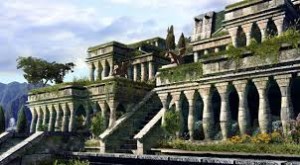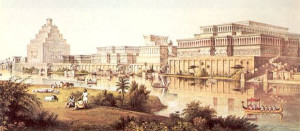CENNI STORICI:
Il primo elenco completo di sette meraviglie compare in un epigramma di Antipatro (di Sidone, II sec. a.C. o di Tessalonica, I sec. a.C.). In questa lista ritroviamo le Piramidi di Giza, il Mausoleo di Alicarnasso, la statua di Zeus ad Olimpia, l’Artemision di Efeso, i Giardini pensili di Babilonia e il Colosso di Rodi ma anche le Mura di Babilonia, mentre manca il Faro di Alessandria.Giuseppe Flavio (I sec. d.C.), basa la sua relazione su quella di un sacerdote babilonese del Dio Marduk, Berosso, vissuto tra IV e III sec. a.C., e dice che i giardini erano stati voluti dal sovrano Nabucodonosor (regnante tra 602 e 594 a.C.) ma, non si è trovata menzione di questa meraviglia nelle tavolette degli archivi del Re. Altri accenni ci vengono dalla citazione di Clitarco di Alessandria (285-246 a.C.) che descrive la vita di Alessandro Magno in dodici libri. I giardini pensili appaiono come quinta ornamentale degli ultimi giorni di Alessandro, anche se è difficile pensare che questi siano rimasti intatti per tre secoli. Nella lista di Diodoro Siculo (90-27 a. C) sono presenti le Piramidi e l’obelisco di Semiramide, mentre, pur descrivendo i giardini e le mura di Babilonia, non li annovera fra le meraviglie. L’Eden descritto da quest’ultimo risulta costruito su terrazze che fanno pensare ad una ziqqurat ; con base quadrata o a forma di U appoggiata sulle mura di Babilonia (che rientrano spesso nelle liste antiche).
Strabone (60-21/24 a. C.) nella sua relazione si concentra molto sul sistema di sollevamento dell’acqua, ovvero la cosiddetta “vite di Archimede”. Lo storico greco fa una descrizione particolareggiata dei giardini , ma egli afferma anche che Babilonia era ridotta ad un deserto; se mai c’era stata questa meraviglia sicuramente non era più riconoscibil al suo tempo. Marziale (40-104 d.C.), tra i fabricarum septem miracula, nomina Babilonia e l’ Assyrius labor, cioè le mura e i giardini; come anche Gregorio Nazianzeno (329-290 d. C.) o ancora prima di loro, Filone di Bizanzio (280-220 a. C.) che li descrive in modo dettagliato in relazione alle pompe idrauliche. Altra descrizione della struttura dei giardini ci viene fatta da Curzio Rufo (I-II secolo d. C. o III-IV secolo d. C.). Egli accettò la versione colonnata dei Giardini Pensili e quella a “gallerie”.
Per quanto riguarda la realizzazione dei Giardini, Diodoro dice che a chiedere tale meraviglia fu la concubina di “ un re siro” o, ancora, Giuseppe Flavio li attribuisce alla sposa di Nabucodonosor, Amytis (figlia del re dei Medi Astiage) in quanto ella aveva nostalgia dei monti della sua patria.
STUDI:
Dove erano situati questi Giardini?
- La prima teorie ci viene fornita da Robert Koldeway, archeologo tedesco che scavò a Babilonia tra 1889-1917. La sua teoria ipotizza che essi erano situati nell’angolo nord-orientale del Palazzo Meridionale, in quanto qui vi era un’enorme struttura coperta da volte a botte e composta da quattordici stanze. A favore della sua teoria fù il ritrovamento, in una di queste stanze, di un pozzo con fori ed identificato come elemento per il sistema idrico. Questa ipotesi aveva un limite ovvero la lontananza dell’Eufrate.
- A causa della lontananza del fiume, Wiseman li colloca sopra e a settentrione della grande muratura a ovest del Palazzo Sud.
- Stevenson propose un’altra tesi , ovvero che i Giardini erano situati in una struttura indipendente, non ancora identificata, vicino al Palazzo Meridionale.
- Secondo Rawlinson, il padre dell’assiriologia moderna, un bassorilievo di Assurnasirpal riproduce i Giardini Pensili ed a cui si ispirano le descrizione posteriori. Infatti tale descrizione, fatta dal re per il suo palazzo di Nimrud, è impressionante e corrisponde al disegno fatto da Layard, il cui bassorilievo originale è andato perduto.
- Uno studio recente è stato fatto da Stephanie Dalley (Università di Oxford). Ella ha ipotizzato che i Giardini sono da collocarsi non a Babilonia ma a Ninive. A favore della sua tesi ci sono diversi elementi. Il primo è la presenza di iscrizioni reali di Sennacherib ( VIII-VII a. C.) che riportano la costruzione di un acquedotto per l’irrigazione di bellissimi giardini. Secondo la studiosa il termine “siro” che cita Diodoro è da interpretare come assiro e “Siria” come Assiria. Sicuramente l’irrigazione a Ninive era più semplice, l’acqua che arrivava dagli Zagros e Tauro era abbondante in tutte le stagoni.
Come possiamo notare l’esistenza di questi Giardini ha affascinato studiosi antichi e moderni.
HISTORICAL REMARKS:
The first list of seven wonders appears in an epigram of Antipater (Sidon, II sec. B.C or Thessalonica, the first century B.C.). In this list we find the Pyramids of Giza, the Mausoleum of Halicarnassus, the Statue of Zeus at Olympia, the Artemision of Ephesus, the Hanging Gardens of Babylon and the Colossus of Rhodes but also the walls of Babylon, while missing the Lighthouse of Alexandria. Josephus Flavius (first century A.D.) based his report on that of a Babylonian priest of the god Marduk, Berossus, who lives between the fourth and third centuries B.C., and says that the gardens had been wanted by King Nebuchadnezzar (reigned between 602 and 594 B.C.), but there isn’t mention of this wonder in the tablets of the archives of the King. There are other hints from Clitarco’s quote of Alexandria (285-246 B.C.), who describes the life of Alexander the Great in twelve books. The hanging gardens appears as ornamental wing of the last days of Alexander, though, it’s hard to think that these remained intact for three centuries. In the list of Diodorus Siculus (90 to 27 B.C.) there are the Pyramids and the Obelisk of Semiramis, while, though describing the gardens and the walls of Babylon, he does not mention of them among the wonders. The Eden described by Diodorus is built on terraces which suggests a ziggurat, with a square base or with U-shaped resting on the walls of Babylon (falling often in ancient lists).
Strabo (60-21 / 24 B.C.) in his report focuses heavily on water lifting system, in other words, the so-called “Archimedes screw.” The greek historian makes a detailed description of the gardens, but he also says that Babylon was reduced to a desert; if ever there was this wonder ,certainly it was no longer recognizable in his time. Martial (40-104 AD), among fabricarum septem miracula, appoints Babylon and the Assyrius labor, that is, the walls and the gardens; as well as Gregory Nazianzen (329-290 A. D.), or even before them, Philo of Byzantium (280-220 B.C.) who describes them in detail in connection to the hydraulic pumps. Another description of the structure of the gardens was made by Curtius Rufus (I – II century A.D. or III – IV century A.D.). He accepted the version of the Hanging Gardens with columns and that to “galleries”.
Regarding the realization of the Gardens Diodorus says that has been the concubine of “a Siro king” to ask such a wonder; Josephus attributes them to the bride of Nebuchadnezzar, Amytis (daughter of the king of the Medes, Astyages), because she was longing for the mountains of her native land.
STUDIES:
Where were these Gardens situated?
- The first theory is by Robert Koldeway, German archaeologist who excavated Babylon from 1889 to 1917. His theory supposes that the Gardens were located in the northeastern corner of the Southern Palace, because here there was a huge structure covered with vaulted ceilings and consisting of fourteen rooms. In support of his theory was the discovery, in one of these rooms, of a well with holes, identified as an element for the water system. This hypothesis had a limit: the remoteness of the Euphrates.
- Because of the remoteness of the river, Wiseman places them above and to the north of the great west wall of the South Palace.
- Stevenson suggests another theory, that the Gardens were in a separate building, not yet identified, near the Southern Palace.
- According to Rawlinson, the modern father of Assyriology, a bas-relief of Ashurnasirpal reproduces the Hanging Gardens and that inspired the description back. In fact this description, made by the king to his palace of Nimrud, is impressive and corresponds to the design made by Layard, whose relief original was lost.
- In a recent study by Stephanie Dalley (Oxford University), she suggested that the Gardens were not located in Babylon but in Nineveh. In support of her argument, there are several items. The first is the presence of royal inscriptions of Sennacherib (VIII-VII BC) showing the construction of an aqueduct to irrigate the beautiful gardens. According to the researcher, the term “siro” citing by Diodorus, is interpreted as Assyrian and “Syria” as Assyria. Surely the irrigation at Nineveh was simpler beacause the water which came from the Zagros and Taurus was abundant in all seasons.
We can see that the existence of these gardens has fascinated ancient and modern scholars.



